Keith Haring au musée d'art contemporain de Lyon, 2008
Sunday, August 03, 2008
Sunday, March 02, 2008
Blogs sur la Figuration Libre mis en ligne par Hervé Perdriolle
>>> Finir en beauté
>>> L'art en sous-sol
>>> Figuration Libre peinture en direct
>>> Keith Haring François Boisrond, 24 H du Mans 1984
>>> Figuration Libre
>>> Figuration Libre, un manifeste
>>> Figuration Libre France/USA
>>> Figuration Libre, juillet 1986
>>> Art Modeste
>>> Finir en beauté
>>> L'art en sous-sol
>>> Figuration Libre peinture en direct
>>> Keith Haring François Boisrond, 24 H du Mans 1984
>>> Figuration Libre
>>> Figuration Libre, un manifeste
>>> Figuration Libre France/USA
>>> Figuration Libre, juillet 1986
>>> Art Modeste
Thursday, October 19, 2006
EIGHTY'S KEYWORDS BASQUIAT, HARING, COMBAS, DI ROSA, BEN, BOISROND, SCHARF, TSENG KWONG CHI, BLANCHARD, CRASH, JAMMES, BERNARD LAMARCHE-VADEL, HERVE PERDRIOLLE, OTTO HAHN, JEFFREY DEITCH, SUZANNE PAGE, ARC, MUSEE ART MODERNE VILLE PARIS, NEW ATTITUDES, PARIS NEW YORK, NY, AFRICA BAMBAATAA, JEAN DE LOISY, JEROME SANS, FARIDEH CADOT, AGNES B, ANNEES 80, FIGURATION LIBRE, & BAD PAINTING, NEUE WILDEN, MADONNA, JEAN-CHARLES DE CASTELBAJAC, WARHOL, ART MODESTE, GRAFFITI, GONDRY, CARRO ET JEUNET, ROBERT FRASER, LONDRES, LONDON, TONY SCHAFRAZI, FASHION MODA, FUN GALLERY, YVON LAMBERT, GALERIE BEAUBOURG, SIDNEY JANIS, STROUMPF, CONTEMPORARY ART, PARIS USA …
Friday, September 08, 2006
Basquiat, Crash, Haring, Scharf, Tseng Kwong Chi, Blanchard, Boisrond, Combas, Di Rosa, Jammes. Figuration Libre, 5 /5, France / USA.


Rémi Blanchard
Figuration Libre, 5 /5, France / USA
Jean-Michel Basquiat, Crash, Keith Haring, Kenny Scharf, Tseng Kwong Chi, Rémi Blanchard, François Boisrond, Robert Combas, Hervé et Richard Di Rosa, Louis Jammes.
Commissaires/curators Otto Hahn et Hervé Perdriolle, ARC, Musée d'Art Moderne de la Ville de Paris, 1984, photos Tristan Valès.
Its real justification here is based on effect of fundamental freedom first affirmed by an art free of obligations, of refusals, of allegiances; and even free from references; free precisely in its excessive borrowing and in the laminating of what it borrows; free in the impertinence with which it flattens out trough a mixing by collage, outside of hierarchies related to any known category of art, outside of all traditional, popular or trivial history.
The energy, the effects of liberty, the speed, the spontaneity, and the highly emotive lavishness of this art, in which the body is loosened up by the music closely associated with it, imposes its own rhythm, directly plugged into a sensitive and nervous highvoltage network. Intermingling humor and a frenzy that does not exclude anxiety and violence, free at last, this art of the cultural, historical, and geographical melting pot, has made out of from all this crossbreeding of knowledge and living experience situated at the heart of the most vital and intense experience, irreductible to anything we know (Popism, Surrealism, Graffiti...) and explosive in its quasi pimitive need.
Extrait de la préface de Suzanne Pagé publiée en 1984 dans le catalogue de l’exposition 5/5 Figuration Libre, France/USA, ARC Musée d’Art Moderne de la Ville de Paris.
This is not the first time that an underground art movement ha gone above ground, taking the art establishment by storm. But this is perahps the first time that a movement whose origins were largely in Black and Hispanic popular culture has entered into the art mainstream. It is perhaps the art world equivalent of the tremendous influence that Black jazz music in earlier years. For the firts time ever, the vanguard art worl has opened itself up to the direct entry of Blacks and Hispanics and has begun to welcome them on their own terms.
Unlike the “Primitivism” of artists like Picaso and Matisse who were influenced by Third World art forms and incorparated them into a European approach, artists like Tseng, Scharf, Haring, Basquiat and Crash are creating a hybrid art culture that doesn’t “borrow” from the Third World and popular forms but instead brings them into the mainstream on equal footing.
Extrait du texte de Jeffrey Deitch, publié en 1984 dans le catalogue de l’exposition 5/5 Figuration Libre France/USA, ARC Musée d’Art Moderne de la Ville de Paris.

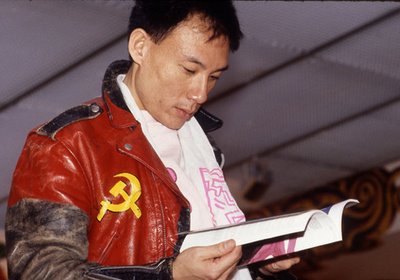
Tseng Kwong Chi

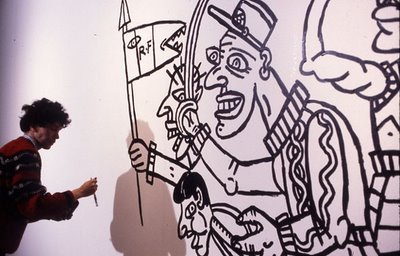

Robert Combas
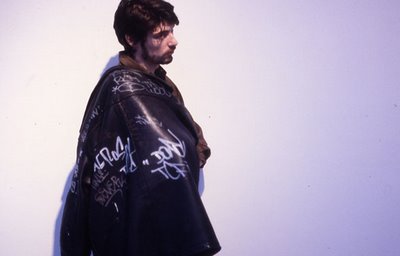
Louis Jammes
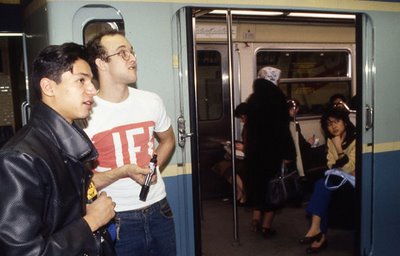
Keith Haring

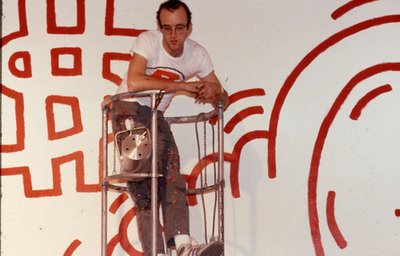


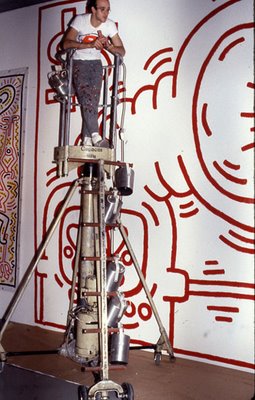
Keith Haring


Hervé Di Rosa

Tseng Kwong Chi et Keith Haring

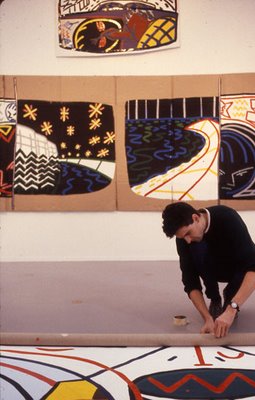
François Boisrond
Le caractère poly-ethnique de l’art de Basquiat, de Haring et compagnie n’est qu’un seul aspect de ce départ radical par rapport à l’art de la génération de l’avant-garde précédente.
Pour bon nombre de plus jeunes d’entre ces artistes talentueux qui firent leur entrée dans le monde artistique pendant les années soixante-dix, le point de départ ne fut pas les galeries, mais les clubs. Leurs modèles ne furent ni Carl André, ni Don Judd, mais les Talking Heads. Leur Dieu ne fut ni Duchamp, ni Jackson Pollock, mais Andy Warhol. Pour beaucoup des membres de ce groupe de jeunes, les limites entre l’art, la mode et le spectacle s’estompèrent. Le but n’est plus actuellement de créer de l’art au sens restrictif du terme, mais de créer de la culture.
Extrait du texte de Jeffrey Deitch, publié en 1984 dans le catalogue de l’exposition 5/5 Figuration Libre France/USA, ARC Musée d’Art Moderne de la Ville de Paris.
Effet de liberté primordiale d’abord affirmée par un art libre de toute adhésion et de tout refus, de toute allégeance et de toute référence même, par l’excès précisément des emprunts, leur laminage réciproque, l’insolent aplatissement d’un brassage par collages étrangers à toute hiérarchie du grand art, du moyen art et du petit art, de l’histoire et de la rue, du noble et du trivial.
Énergies, effets de liberté, aussi, par la vitesse, la spontanéité, la prodigalité, hautement émotives de cet art où le corps délié par la musique sous-jacente impose son propre rythme directement branché sur un réseau sensible et nerveux de haut voltage.
Mixité d’humour et de frénésie qui n’exclut ni l’anxiété ni la violence.
Libre enfin, cet art du melting-pot social, culturel, historique, géographique, faisant de tout ce métissage du savoir et de l’expérience la plus immédiate une expression neuve, au vif de la vie la plus brûlante, irréductible à rien de connu (popisme, surréalisme, graffiti…) et explosive par sa nécessité quasi primitive.
Extrait de la préface de Suzanne Pagé publiée en 1984 dans le catalogue de l’exposition 5/5 Figuration Libre, France/USA, ARC Musée d’Art Moderne de la Ville de Paris.

Robert Combas, affiche de l'exposition

Hervé Di Rosa, couverture du catalogue de l'exposition


Keith Haring, Paris 1984
NEW ATTITUDES
PARIS NEW YORK

New Attitudes, Paris-New York, Musée de Pittsburgh, 1984. Exposition organisée par Sandy Deitch et Tseng Kwong Chi. De gauche à droite et de haut en bas : Kenny Sharf et son bébé, Louis Jammes, Rémi Blanchard, Tseng Kwong Chi, Dan Friedman, Hervé Di Rosa, Keith Haring et Samantha McEwen
(photo Tseng Kwong Chi)
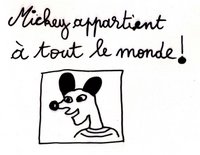
Conférence "Figuration libre, France/USA"
par Hervé Perdriolle , Ecole du Louvre 2006
Si vous avez des documents d'archives (photos, vidéos, catalogues, articles de presse) concernant les expositions ayant réunies certains de ces artistes français et américains (Statments One, New York; 5/5 France-USA, Paris; Paris-NY, Robert Fraser Gallery Londres; New Attitudes Paris-New York, Pittsburgh, etc.), merci de prendre contact avec Hervé Perdriolle
If you have archives documents (photos, videos, catalogues, press articles) concerning the exhibitions have gathered certain of these americans and french artists (Statments One, New York; 5/5 France-USA, Paris; Paris-NY, Robert Fraser Gallery Londres; New Attitudes Paris-New York, Pittsburgh, etc.), please get in touch with Hervé Perdriolle
Exposition, publication, conférence, ...,
contact Hervé Perdriolle

Figuration Libre, Une initiation à la Culture Mass-Média, Guide des Mentalités Nouvelles, Edition Axe Sud, 1984. Dessin de couverture Rémi Blanchard. (more)


Rémi Blanchard
Figuration Libre, 5 /5, France / USA
Jean-Michel Basquiat, Crash, Keith Haring, Kenny Scharf, Tseng Kwong Chi, Rémi Blanchard, François Boisrond, Robert Combas, Hervé et Richard Di Rosa, Louis Jammes.
Commissaires/curators Otto Hahn et Hervé Perdriolle, ARC, Musée d'Art Moderne de la Ville de Paris, 1984, photos Tristan Valès.
Its real justification here is based on effect of fundamental freedom first affirmed by an art free of obligations, of refusals, of allegiances; and even free from references; free precisely in its excessive borrowing and in the laminating of what it borrows; free in the impertinence with which it flattens out trough a mixing by collage, outside of hierarchies related to any known category of art, outside of all traditional, popular or trivial history.
The energy, the effects of liberty, the speed, the spontaneity, and the highly emotive lavishness of this art, in which the body is loosened up by the music closely associated with it, imposes its own rhythm, directly plugged into a sensitive and nervous highvoltage network. Intermingling humor and a frenzy that does not exclude anxiety and violence, free at last, this art of the cultural, historical, and geographical melting pot, has made out of from all this crossbreeding of knowledge and living experience situated at the heart of the most vital and intense experience, irreductible to anything we know (Popism, Surrealism, Graffiti...) and explosive in its quasi pimitive need.
Extrait de la préface de Suzanne Pagé publiée en 1984 dans le catalogue de l’exposition 5/5 Figuration Libre, France/USA, ARC Musée d’Art Moderne de la Ville de Paris.
This is not the first time that an underground art movement ha gone above ground, taking the art establishment by storm. But this is perahps the first time that a movement whose origins were largely in Black and Hispanic popular culture has entered into the art mainstream. It is perhaps the art world equivalent of the tremendous influence that Black jazz music in earlier years. For the firts time ever, the vanguard art worl has opened itself up to the direct entry of Blacks and Hispanics and has begun to welcome them on their own terms.
Unlike the “Primitivism” of artists like Picaso and Matisse who were influenced by Third World art forms and incorparated them into a European approach, artists like Tseng, Scharf, Haring, Basquiat and Crash are creating a hybrid art culture that doesn’t “borrow” from the Third World and popular forms but instead brings them into the mainstream on equal footing.
Extrait du texte de Jeffrey Deitch, publié en 1984 dans le catalogue de l’exposition 5/5 Figuration Libre France/USA, ARC Musée d’Art Moderne de la Ville de Paris.


Tseng Kwong Chi



Robert Combas

Louis Jammes

Keith Haring





Keith Haring


Hervé Di Rosa

Tseng Kwong Chi et Keith Haring


François Boisrond
Le caractère poly-ethnique de l’art de Basquiat, de Haring et compagnie n’est qu’un seul aspect de ce départ radical par rapport à l’art de la génération de l’avant-garde précédente.
Pour bon nombre de plus jeunes d’entre ces artistes talentueux qui firent leur entrée dans le monde artistique pendant les années soixante-dix, le point de départ ne fut pas les galeries, mais les clubs. Leurs modèles ne furent ni Carl André, ni Don Judd, mais les Talking Heads. Leur Dieu ne fut ni Duchamp, ni Jackson Pollock, mais Andy Warhol. Pour beaucoup des membres de ce groupe de jeunes, les limites entre l’art, la mode et le spectacle s’estompèrent. Le but n’est plus actuellement de créer de l’art au sens restrictif du terme, mais de créer de la culture.
Extrait du texte de Jeffrey Deitch, publié en 1984 dans le catalogue de l’exposition 5/5 Figuration Libre France/USA, ARC Musée d’Art Moderne de la Ville de Paris.
Effet de liberté primordiale d’abord affirmée par un art libre de toute adhésion et de tout refus, de toute allégeance et de toute référence même, par l’excès précisément des emprunts, leur laminage réciproque, l’insolent aplatissement d’un brassage par collages étrangers à toute hiérarchie du grand art, du moyen art et du petit art, de l’histoire et de la rue, du noble et du trivial.
Énergies, effets de liberté, aussi, par la vitesse, la spontanéité, la prodigalité, hautement émotives de cet art où le corps délié par la musique sous-jacente impose son propre rythme directement branché sur un réseau sensible et nerveux de haut voltage.
Mixité d’humour et de frénésie qui n’exclut ni l’anxiété ni la violence.
Libre enfin, cet art du melting-pot social, culturel, historique, géographique, faisant de tout ce métissage du savoir et de l’expérience la plus immédiate une expression neuve, au vif de la vie la plus brûlante, irréductible à rien de connu (popisme, surréalisme, graffiti…) et explosive par sa nécessité quasi primitive.
Extrait de la préface de Suzanne Pagé publiée en 1984 dans le catalogue de l’exposition 5/5 Figuration Libre, France/USA, ARC Musée d’Art Moderne de la Ville de Paris.

Robert Combas, affiche de l'exposition

Hervé Di Rosa, couverture du catalogue de l'exposition


Keith Haring, Paris 1984
NEW ATTITUDES
PARIS NEW YORK

New Attitudes, Paris-New York, Musée de Pittsburgh, 1984. Exposition organisée par Sandy Deitch et Tseng Kwong Chi. De gauche à droite et de haut en bas : Kenny Sharf et son bébé, Louis Jammes, Rémi Blanchard, Tseng Kwong Chi, Dan Friedman, Hervé Di Rosa, Keith Haring et Samantha McEwen
(photo Tseng Kwong Chi)

Conférence "Figuration libre, France/USA"
par Hervé Perdriolle , Ecole du Louvre 2006
Si vous avez des documents d'archives (photos, vidéos, catalogues, articles de presse) concernant les expositions ayant réunies certains de ces artistes français et américains (Statments One, New York; 5/5 France-USA, Paris; Paris-NY, Robert Fraser Gallery Londres; New Attitudes Paris-New York, Pittsburgh, etc.), merci de prendre contact avec Hervé Perdriolle
If you have archives documents (photos, videos, catalogues, press articles) concerning the exhibitions have gathered certain of these americans and french artists (Statments One, New York; 5/5 France-USA, Paris; Paris-NY, Robert Fraser Gallery Londres; New Attitudes Paris-New York, Pittsburgh, etc.), please get in touch with Hervé Perdriolle
Exposition, publication, conférence, ...,
contact Hervé Perdriolle

Figuration Libre, Une initiation à la Culture Mass-Média, Guide des Mentalités Nouvelles, Edition Axe Sud, 1984. Dessin de couverture Rémi Blanchard. (more)